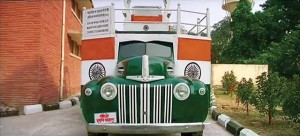

The ‘Road to Sangam’ Hindi movie features a World War II era Ford pick-up. The movie is based on a simple story of a God fearing, devout Muslim mechanic named Hashmatullah. He stays at Allahabad and is entrusted with the job of repairing the V8 engine of the Ford pick-up not knowing the historic significance of the vehicle. The Ford pick-up is portrayed in the movie as the one that once carried the ashes of Mahatma Gandhi to the Triveni Sangam. Assuming speed as an imaginary set of sequences lead to the time when Mahatma Gandhi’s grandson comes to know that one of the 20 parts of his grandfather’s ashes is lying in the locker of Orrisa State Bank. He approaches the government, which decides to honour his request to disperse the ashes in the same way as the other parts, and by using the same Ford pick-up that was used in 1948. The vehicle is shown in the possession of the respective state government. As Hashmatullah starts work on the engine, oblivious of its historic importance, communal unrest breaks out in his city. He almost gets dragged into it. When a media reporter approaches him, and he is told of the significance of the vehicle whose engine he is repairing, Hashmatullah is caught between honouring his commitment to repair the engine and to stop work because a Muslim leader in his city has called for a strike. After learning that Gandhi held the people of the Muslim community in his country with high esteem, Hashmatullah decides to repair the engine. He is insulted by people of his community for not honouring the call of strike. Eventually, he wins their hearts.
The World War II era Ford pick-up featured in the movie is a half-tone Ford truck. It is a light-duty truck that marks a departure from contemporary car shape, and featured headlamps that were completely faired-in and mounted inboard of the fender with end-parking lights. The truck came with a heavy hood moulding and side hood louvres. Door handles and headlight bezels were of chrome on early examples. Structured on a rugged, ladder-type chassis with four cross-members, which provided greater strength and more body mounts, the pick-up truck employed semi-elliptic leaf springs at each corner. A part of the suspension was the hydraulic, double-acting shock absorbers. A tubular propeller shaft and open Hotchkiss Drive were a part of the driveline. The eight-cylinder 79C engine produced 100 hp, and was mated to a four-speed transmission. In production from 1942 to 1947, the Ford pick-up, starting 1946, came to feature self-centring brakes. While stake and pick-up bodies were built in 1945, in 1946, a sedan delivery and panel trucks were added to the range. Wheels were black.

























